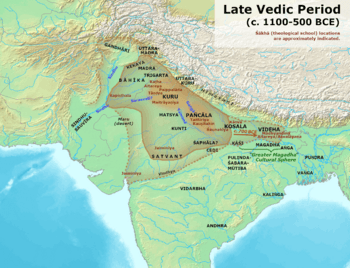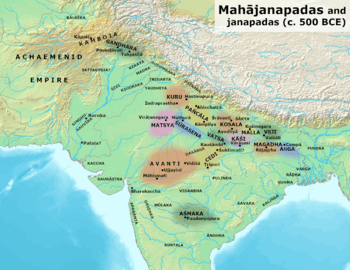Anga facts for kids
Quick facts for kids
Aṅga
|
|
|---|---|
| Unknown (~1100 BCE)–c. 530 BCE | |

Aṅga and other kingdoms of the late Vedic period
|
|

|
|
| Capital | Champapuri (near modern Bhagalpur) and Malini (near modern Munger), Bihar |
| Religion | Historical Vedic religion Buddhism Jainism |
| Government | Monarchy |
|
•
|
Brahmadatta |
| Raja (King) | |
| Historical era | Iron Age |
|
• Established
|
Unknown (~1100 BCE) |
|
• Disestablished
|
c. 530 BCE |
Anga (pronounced Aṅga) was an ancient kingdom in eastern India. It existed during the Iron Age, a time when people started using iron tools. The people from Anga were called the Āṅgeyas.
Anga was one of the "sixteen great nations" mentioned in old Buddhist texts. It also appears in ancient Jain writings, showing its importance.
Contents
Where was the Anga Kingdom Located?
Anga was mainly located between the Champā River in the west and the Rajmahal hills in the east. Sometimes, its land stretched all the way to the sea in the south. It even included the area of Magadha to its west at certain times.
The capital city of Anga was called Campā. It was located where the Campā and Gaṅgā rivers met. Today, this area is near the villages of Campāpurī and Champanagar in Bihar, India. Ancient stories say Campā was also known as Kāla-Campā. Some old texts called it Mālinī.
Other important cities in the Anga kingdom were Assapura and Bhaddiya.
How did Anga Get its Name?
There are a couple of stories about how Anga got its name.
The Story of Prince Anga
According to the ancient Indian epic, the Mahabharata, and other old texts, the kingdom was named after Prince Anga. He was the founder of the kingdom. The story says that a king named Vali had no sons. He asked a wise man, Dirghatamas, to bless him with children. The sage had five sons with the queen Sudesna. These princes were named Aṅga, Vaṅga, Kaliṅga, Sumha, and Pundra.
The Story of Shiva and Kamadeva
Another ancient epic, the Ramayana, tells a different story. It says that Anga was named after a place where the god Shiva's body parts (called aṅgas) were scattered. This happened after Kamadeva, the god of love, was affected by Shiva's power there.
What is the History of Anga?
Anga was first mentioned in a very old text called the Atharvaveda. It was linked to other groups like the Gāndhārīs and Māgadhīs. The first king of Anga might have been Aṅga Vairocana. He was a ruler who followed a special Aryan ritual.
Anga as a Powerful Kingdom
Anga was a strong kingdom during the Iron Age. One of its kings was even said to have achieved a "world conquest." The capital city, Campā, was one of the six most important cities in northern India. It was a very rich trading center. From Campā, traders sailed to a place called Suvarṇabhūmi, which means "Land of Gold."
Anga and Jainism
In the 6th century BCE, Dadhivāhana was the king of Anga. His wife, Padmāvatī, was a princess from the Licchavika republic. Her uncle, Ceṭaka, was a leader who followed the teachings of Mahavira, a great teacher of Jainism. Ceṭaka made his capital, Vesālī, a strong center for Jainism. His daughters' marriages helped spread Jainism across northern India.
Dadhivāhana and Padmāvatī had a daughter named Candanā. She became the first woman to convert to Jainism. This happened shortly after Mahāvīra reached a special state of knowledge called Kevala.
Wars and Alliances
Under King Dadhivāhana, Anga conquered its neighbor to the west, the state of Magadha. This brought Anga into contact with Magadha's western neighbor, Vatsa. The king of Vatsa, Śatānīka, attacked Anga's capital, Campā. He was worried about Dadhivāhana's growing power.
However, Dadhivāhana wanted peace with Vatsa. He gave his daughter in marriage to Śatānīka's son, Udayana. Later, after Śatānīka died, another king named Pradyota from Avanti took control of Vatsa. Udayana became a captive at Pradyota's court.
While Udayana was held captive, the state of Kaliṅga attacked Anga and captured King Dadhivāhana. Once Pradyota helped Udayana get his throne back, Udayana was able to defeat Kaliṅga. He then helped Dadhivāhana return to the throne of Anga. Dadhivāhana's daughter, Priyadarśikā, also married Udayana.
The End of Anga's Prosperity
Anga's time of wealth and power ended in the middle of the 6th century BCE. The crown prince of Magadha, Bimbisāra Śreṇika, defeated and killed the Anga king, Brahmadatta. This was to get revenge for his father's defeat against Anga. After this, Anga became part of the Magadhan empire. Campā became a city ruled by a Magadhan governor.
Later History of Anga
Many centuries later, around the end of the 4th century CE, a Chinese monk named Faxian visited the area. He noted that many Buddhist temples still existed in Campā. By this time, the kingdom of Anga had long ceased to exist.
Varman Rule in Anga
In the 11th and 12th centuries, the Anga region was controlled by the Varman dynasty. An old copper plate from Bhojavarman mentions that Jatavarman, led by his father Vajravarman, conquered Anga. This established their family's rule in the region.
See Also
- Anga (region)
- Magadha
- Anga Lipi
- Mahajanapadas
- Magadha-Anga war
- History of India
- History of Hinduism

